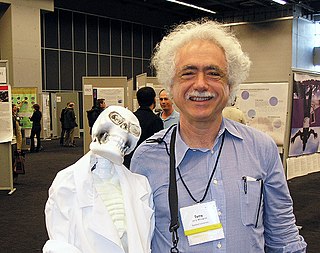Terry Winograd
From Wikipedia, the free encyclopedia
Terry Allen Winograd (born February 24, 1946) is an American professor of computer science at Stanford University, and co-director of the Stanford Human-Computer Interaction Group. [1] He is known within the philosophy of mind and artificial intelligence fields for his work on natural language using the SHRDLU program.
Contents |
[edit] Life and work
SHRDLU was written as a PhD thesis at MIT in the years from 1968-70. In making the program Winograd was concerned with the problem of providing a computer with sufficient "understanding" to be able to use natural language. Winograd built a blocks world, restricting the program's intellectual world to a simulated "world of toy blocks". The program could accept commands such as, "Find a block which is taller than the one you are holding and put it into the box" and carry out the requested action using a simulated block-moving arm. The program could also respond verbally, for example, "I do not know which block you mean." The SHRDLU program can be viewed historically as one of the classic examples of how difficult it is for a programmer to build up a computer's semantic memory by hand and how limited or "brittle" such programs are.[2]
In 1973, Winograd moved to Stanford University and developed an AI-based framework for understanding natural language which was to give rise to a series of books. But only the first volume (Syntax) was ever published. "What I came to realize is that the success of the communication depends on the real intelligence on the part of the listener, and that there are many other ways of communicating with a computer that can be more effective, given that it doesn’t have the intelligence."[3]
His approach shifted away from Artificial Intelligence after meeting up with the Chilean philosopher Fernando Flores with whom he published a critical appraisal from a perspective based in phenomenology. In the latter part of the 1980s, Winograd worked with him on an early form of groupware. Their approach was based on conversation-for-action analysis.
In the early 1980s, Winograd was a founding member and national president of Computer Professionals for Social Responsibility, a group of computer scientists concerned about nuclear weapons, SDI, and increasing participation by the U.S. Department of Defense in the field of computer science.[4]
In general, Winograd's work at Stanford has focused on software design in a broader sense than software engineering. In 1991 he founded the "Project on People, Computers and Design" in order to promote teaching and research into software design. The book "Bringing Design to Software" describes some of this work. His thesis is that software design is a distinct activity from both analysis and programming, but it should be informed by both, as well as by design practices in other professions (textile design, industrial design, etc).
Starting in 1995, Winograd served as adviser to Stanford PhD student Larry Page[5], who was working on a research project involving web search. In 1998, Page took a leave of absence from Stanford to co-found Google. In 2002, Winograd took a sabbatical from teaching and spent some time at Google as a visiting researcher.[6] There, he studied the intersection of theory and practice of human-computer interaction.
Recently, Winograd has continued to research collaborative computing, including uses of ubiquitous computing in collaborative work. Today, Winograd continues to do research at Stanford and teach classes and seminars in human-computer interaction. In addition to the Computer Science Dept., Winograd is associated with the Hasso Plattner Institute of Design at Stanford, also known as the "d.school", which he helped found.[7]
[edit] See also
[edit] Publications
Books by Terry Winograd
- 1972. Understanding Natural Language Academic Press, New York.
- 1982. Language As A Cognitive Process, Volume 1, Syntax Addison-Wesley.
- 1986. Understanding Computers and Cognition: A New Foundation for Design (with Fernando Flores) Ablex Publ Corp.
- 1992. Usability: Turning Technologies into Tools (with Paul S. Adler) Oxford University Press.
- 1996. Bringing Design to Software ACM Press.
[edit] References
- ^ Stanford HCI Group
- ^ SHRDLU overview
- ^ [1]
- ^ 'Past CPSR Board Members', CPSR Web site - Winograd listed as board member 1983-1996.
- ^ Larry Page's Stanford home page visited Nov 5, 2006
- ^ 'How Google Works', David Carr, Baseline Magazine, July 6, 2006
- ^ Terry Winograd's biography at the d.school
[edit] External links
- Oral history interview with Terry Allen Winograd Charles Babbage Institute, University of Minnesota, Minneapolis -- 65-page interview describes his education in computer science and introduction to linguistics at the Massachusetts Institute of Technology (MIT). He discusses the work of Marvin Minsky and others in artificial intelligence. He describes his move to the Stanford Artificial Intelligence Laboratory and his additional linguistic research at Xerox-PARC. Winograd compares the approach to artificial intelligence at MIT and Stanford. He describes his involvement with obtaining funding from the Information Processing Techniques Office of the Defense Advanced Research Projects Agency.
- Stanford HCI Group
- Terry Winograd's faculty page
- Interviewed by Morten Thanning Vendel


